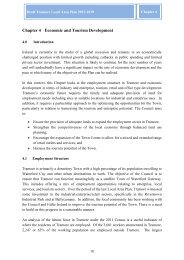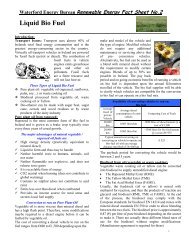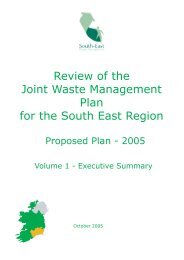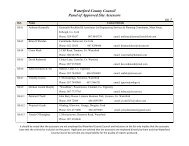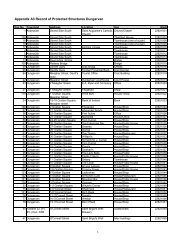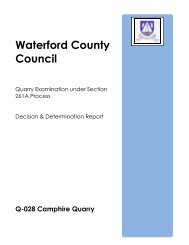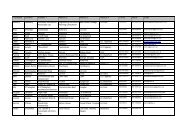East Waterford Water Supply Scheme - Waterford County Council
East Waterford Water Supply Scheme - Waterford County Council
East Waterford Water Supply Scheme - Waterford County Council
- No tags were found...
You also want an ePaper? Increase the reach of your titles
YUMPU automatically turns print PDFs into web optimized ePapers that Google loves.
<strong>East</strong> <strong><strong>Water</strong>ford</strong> <strong>Water</strong> <strong>Supply</strong> <strong>Scheme</strong> - Principal ElementsCappawhiteContractorsBack Cover: Map showing extent of <strong>East</strong> <strong><strong>Water</strong>ford</strong> <strong>Water</strong> <strong>Supply</strong> <strong>Scheme</strong>Front Cover: Adamstown <strong>Water</strong> Treatment Plant<strong>East</strong> <strong><strong>Water</strong>ford</strong> <strong>Water</strong> <strong>Supply</strong> <strong>Scheme</strong>
The <strong>East</strong> <strong><strong>Water</strong>ford</strong> <strong>Water</strong> <strong>Supply</strong><strong>Scheme</strong> is the primary water supplyin Co. <strong><strong>Water</strong>ford</strong> and supplies potablewater to <strong><strong>Water</strong>ford</strong> City and the easternparts of the county including Tramoreand Dunmore <strong>East</strong>.NEED FOR DEVELOPMENTThe <strong>East</strong> <strong><strong>Water</strong>ford</strong> <strong>Water</strong> <strong>Supply</strong> <strong>Scheme</strong> (EWWSS)was originally constructed and commissioned in 19843to provide 25,000m approx. of potable water on a dailybasis. Since then, steady population growth and increasesin commercial/industrial development and tourism in theeastern region of <strong>County</strong> <strong><strong>Water</strong>ford</strong> has demanded asignificant increase in the capacity of the potable watersupply facilities for the region.<strong><strong>Water</strong>ford</strong> <strong>County</strong> <strong>Council</strong> appointed MC O’Sullivan ConsultingEngineers (now RPS Consulting Engineers) to initiallyexamine and report on the feasibility of expanding theoverall capacity of the EWWSS, while conforming withthe various Environmental Legislation, Directives andRegulations governing the sourcing, treatment andsupply of drinking water in Ireland.From Ballyshonock DamFrom Portlaw Raw <strong>Water</strong> P.S.From Knockaderry Raw <strong>Water</strong> P.S.Raw <strong>Water</strong> Balancing TankPoly & AlumDosingPre-FiltrationBackwash <strong>Water</strong> PipeDesign proposals were approved by the Department of theEnvironment, Heritage and Local Government, outlining anexpanded raw water intake and supply network, togetherwith an expanded treatment plant at Adamstown anddistribution pipelines capable of meeting population demandsfor the foreseeable future.CONSTRUCTIONThe expansion/upgrade works were carried out in two phasesover a number of years through various separate Civil andMechanical & Electrical contracts for Trunk Mains, Reservoirs,Distribution Mains, Pumping Equipment, the Mahon RiverIntake and staged extensions to the Adamstown <strong>Water</strong>Treatment Plant (WTP) at Kilmeaden in order to double itsoriginal output.Phase 1 included the construction of a number of trunkpotable water distribution mains with pumping stations andreservoirs from Adamstown WTP to <strong><strong>Water</strong>ford</strong> City, Tramoreand their environs.Phase 2 completes the scheme with the Mahon River Intakeand Pumping Station, trunk main to Ballyshonock reservoirand extension to Adamstown WTP resulting in a duplicationof the water treatment capacity.Splitter ChamberBackwash Recovery TankSettling TankSchematic Section Through Adamstown Treatment PlantBackwash <strong>Water</strong> PipeSludge Draw-Off PipeFilter BedMahon Aerial ViewMahon Pumping StationSludge DewateringChlorine, Fluorine& Lime DosingPost FiltrationWaste Material SkipFiltered <strong>Water</strong> ReservoirMAJOR ELEMENTS OF THE WORKSEWWSS Stage 2 Phase 2 Total Cost €18.5 millionMahon Pump House & Rising-main:Three Multi-stage Turbine Pumps (duty,duty-assist, standby).<strong>Water</strong> abstraction variable from 16,800 to 38,400m/day, controlled remotely from Adamstown WTP in31,200m /day steps.18km of raw water mains.Ammonia Analyser providing continuous monitoringat the intake and automatic close down of thepumps in the event of unacceptable pollutants inthe water.The plant installed at Mahon Intake andBallyshonock reservoir is capable of interfacingwith existing telemetry system at Adamstown WTP.Adamstown <strong>Water</strong> Treatment Plant:Upgraded Alum and Polyelectrolyte dosing.Modifications to Splitter Chamber to allow foradditional Settling Tanks.Four new Settling Tanks, bringing total to eight.Four new Filters, bringing total to eight.Upgraded chlorination and lime dosing.Facility to dewater sludge drawn off from SettlingTanks and allow re-treatment of water recoveredfrom sludge dewatering and also water recoveredfrom Filter backwashing.26 million litres/day upgrade of Adamstown WTP.3WATER TREATMENT PROCESSThe reservoir at Ballyshonock was formed in the 1960s bythe construction of a dam on the Dawn River and in recentyears has suffered from very low water levels during dryperiods. The commissioning of the Mahon River Intake,upriver from Bunmahon, and associated pumping main toBallyshonock reservoir, ensures that the reservoir levels arealways maintained at a level to meet demand.The water from Ballyshonock and Knockaderry reservoirstogether with water abstracted from the river Clodiagh atPortlaw is delivered to Adamstown WTP. It is initially dosedwith Alum which causes chemical attraction between smallparticles in the water causing larger ‘flocs’ of particles toform, followed by dosing with Polyelectrolyte which enhancesthe initial chemical attraction by electrostatic means.The water is then passed into the bottom of the SettlingTanks where the rate of settlement of the ‘flocs’ is greaterthan the upward flow rate of the water. The settled ‘flocs’form a blanket of coagulated particles drawn off the bottomof the tanks as sludge, while the now clarified water flowsover weirs at the top of the tanks.The clarified water is then passed through downward flowsand filters where any remaining small particles are trappedin the sand. As the sand slowly becomes clogged with theseparticles, the filters are periodically taken out of service andbackwashed with filtered water to clean them.The filtered water is drawn off at the base of the filters andchlorinated to remove bacteria and other harmful pathogens.Finally the water is dosed with lime to adjust its acidity to anacceptable level before leaving the works as potable water.The sludge from the Settling Tanks is passed to a sludgedewatering centrifuge. The water released is then pumped backto the plant inlet for re-treatment, as is the water from filterbackwashing, resulting in minimal wastage of water togetherwith reduced volumes of sludge waste.Ballyshonock ReservoirBENEFITSThe completion of the <strong>East</strong> <strong><strong>Water</strong>ford</strong><strong>Water</strong> <strong>Supply</strong> <strong>Scheme</strong> will ensure that:3Potable water supplies of up to 52,000m per dayare capable of being delivered to <strong>East</strong> <strong>County</strong><strong><strong>Water</strong>ford</strong>, including <strong><strong>Water</strong>ford</strong> City.Existing high quality of the potable water supplyto consumers is maintained.Potential for increased domestic, commercial andindustrial development in <strong>East</strong> <strong><strong>Water</strong>ford</strong> and<strong><strong>Water</strong>ford</strong> City is catered for.The natural environment has been preserved andenhanced during the construction and operationof the additional plant.Adamstown Treatment Plant Schematic




